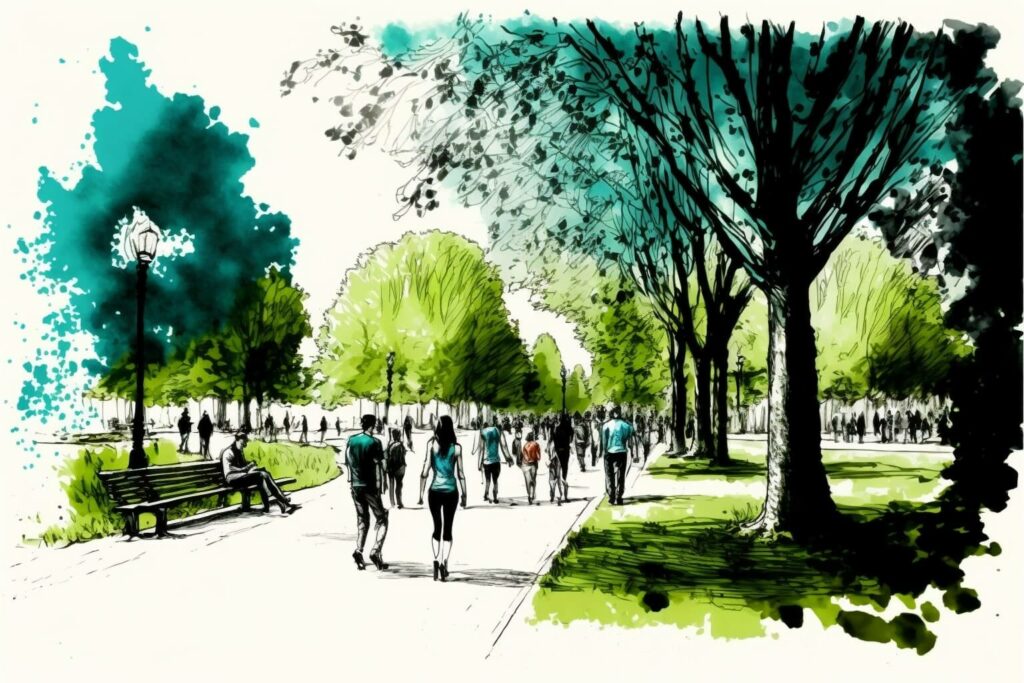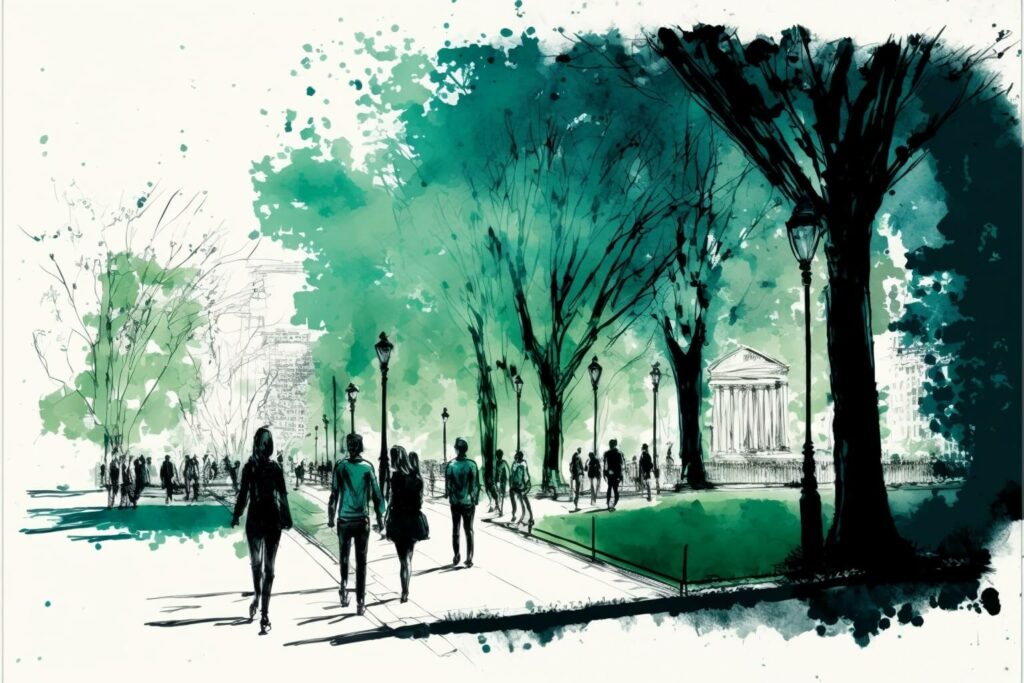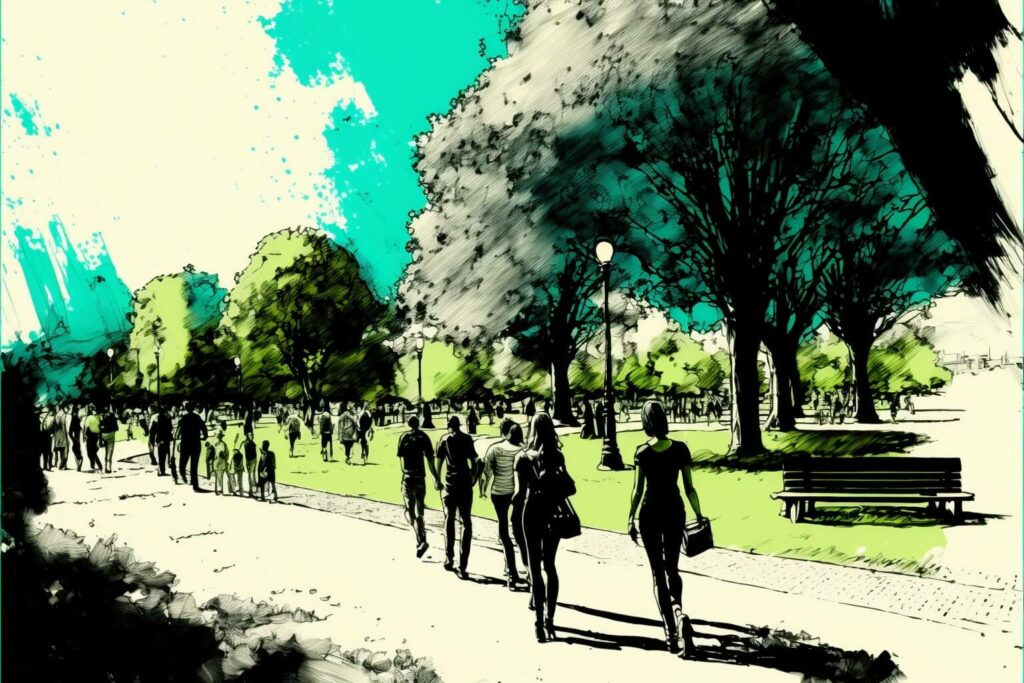






A 2-day immersion into the future of sustainable construction
Green spaces are an essential component of healthy and vibrant communities.
These spaces provide numerous benefits, including improving mental and physical health, fostering social connections, protecting the environment, and enhancing economic development.
In this article, we will explore how green spaces can contribute to the well-being of communities and cities and discuss strategies for creating and maintaining green spaces.
We will also highlight some successful examples of green space projects worldwide. Whether you are a community leader, a park enthusiast, or simply someone who values the importance of green space, we invite you to read on and learn more about this critical topic.












A 2-day immersion into the future of sustainable construction
What are green spaces, and why are they important?
Green spaces are areas designated for recreational or conservation purposes and covered in vegetation, such as grass, trees, and plants. These areas can range in size from small neighborhood parks to extensive national forests and can be found in urban and rural settings.
Green spaces are essential for a variety of reasons. They provide a place for people to engage in outdoor activities and exercise, such as walking, running, or playing sports. They also serve as a natural environment where people can relax and respite from daily stresses.
In addition to the benefits they provide to people, green spaces are also crucial for the environment. They help filter pollutants and purify the air, reduce the heat island effect in urban areas, and provide a habitat for various plants and animals.
Green spaces are also crucial for the overall health and well-being of communities. Studies have shown that access to green spaces can improve mental health, reduce the risk of chronic diseases such as obesity and heart disease, and even increase life expectancy.
In short, green spaces are an essential part of our communities and our lives. They provide a place for recreation and relaxation, benefit the environment, and improve the health and well-being of those who use them.


How can green spaces benefit communities and cities?
Green spaces provide numerous benefits to communities and cities. These benefits can be grouped into four main categories: social, environmental, economic, and health.
First, green spaces serve as a social hub for communities. They provide a place for people to gather, interact, and build relationships. Green spaces can also host events and activities, such as concerts, festivals, and farmers’ markets, which bring people together and foster a sense of community.
Second, it has numerous environmental benefits. They help filter pollutants and purify the air, reduce the heat island effect in urban areas, and provide a habitat for various plants and animals. In addition, green spaces can help mitigate climate change’s impacts by absorbing carbon dioxide and releasing oxygen.
Third, it can also have economic benefits for communities and cities. They can attract tourists and increase property values, leading to economic development. Green spaces can also create job opportunities through the maintenance and management of these areas.
Finally, green spaces can positively impact the health of communities and cities. Access to green spaces has been linked to improved mental health, reduced stress, and increased physical activity, all of which can improve overall health and well-being.
In conclusion, green spaces provide numerous benefits to communities and cities. They serve as a social hub, have environmental benefits, can contribute to economic development, and positively impact health. As such, towns and communities need to prioritize creating and maintaining green spaces.
How can green spaces be used to address environmental and sustainability issues?
Green spaces can be an essential tool in addressing environmental and sustainability issues. Here are a few ways that it can contribute to a more sustainable future:
- Carbon sequestration: Trees and other vegetation in green spaces absorb carbon dioxide from the atmosphere and store it as carbon in their wood, leaves, and roots. This process, known as carbon sequestration, helps mitigate climate change’s effects.
- Stormwater management can help manage stormwater by intercepting and filtering rainwater runoff. This can help reduce the risk of flooding and erosion and improve water quality flowing into streams and rivers.
- Biodiversity conservation: it can provide habitat for a wide variety of plants and animals, which can help to conserve biodiversity. This can include endangered or threatened species and common species that play critical ecological roles.
- Education and outreach: it can be used as a tool for education and outreach, helping to raise awareness about environmental and sustainability issues. This can involve hosting events, workshops, and educational programs in the green space.
- Community engagement: it can serve as a gathering place for the community and provide opportunities for people to get involved in sustainability efforts. This can include volunteering, participating in community clean-up events, and advocating for environmentally-friendly policies.
By incorporating sustainability considerations into the design and management of green spaces, communities can leverage these spaces as a tool for addressing environmental and sustainability issues.












A 2-day immersion into the future of sustainable construction
How can green spaces help in population health and well-being?
Green spaces can positively impact population health and well-being in several ways. Here are a few examples:
- Physical activity: it provides opportunities for physical activity, such as walking, running, cycling, and playing sports. Engaging in physical activity has numerous health benefits, including improving cardiovascular health, strengthening bones and muscles, and reducing the risk of chronic diseases such as obesity and diabetes.
- Mental health: Access to green spaces has been linked to improved mental health, including reduced stress and anxiety and improved mood and self-esteem. Being in nature has been shown to have a calming and therapeutic effect on the mind, and green spaces provide an opportunity for people to escape the stresses of daily life and connect with the natural world.
- Social connections: it can serve as a social hub for communities, providing a place for people to gather, interact, and build relationships. Strong social connections have been linked to improved health and well-being, including lower rates of depression and anxiety and higher levels of happiness and life satisfaction.
- Air quality: it can improve air quality by filtering pollutants and releasing oxygen. This can positively impact the population’s health, particularly those sensitive to air pollution, such as children, the elderly, and individuals with respiratory conditions.
- Access to healthy food: Some green spaces, such as community gardens, can provide access to fresh, healthy food. This can be especially important for communities that lack access to supermarkets or other sources of fresh produce.
By providing opportunities for physical activity, improving mental health, fostering social connections, improving air quality, and increasing access to healthy food, green spaces can make a significant contribution to population health and wellbeing.
What are some examples of successful green spaces projects?
There are many examples of successful green space projects around the world. Here are a few examples:
- The High Line in New York City: The High Line is a 1.45-mile-long elevated park built on an abandoned railway line in Manhattan. The park, which opened in 2009, has become a popular tourist destination and has revitalized the surrounding neighborhood.
- The Emerald Necklace in Boston: The Emerald Necklace is a series of interconnected parks and green spaces in Boston that landscape architect Frederick Law Olmsted designed in the late 19th century. The park system, which includes the Boston Common and the Public Garden, is considered a masterpiece of landscape design and has been recognized as a National Historic Landmark.
- The Park of the Monsters in Bomarzo: The Park of the Monsters, also known as the Sacro Bosco, is a 16th-century Italian garden filled with surrealist sculptures and landscaping. The park, a UNESCO World Heritage Site, has become a popular tourist destination and is known for its unique and imaginative design.
- The Singapore Botanic Gardens: The Singapore Botanic Gardens is a 74-acre botanical garden home to over 10,000 species of plants. The garden, established in 1859, is a popular tourist destination and has been recognized as a UNESCO World Heritage Site.
These are just a few examples of successful green space projects. There are many successful green spaces worldwide, ranging from small neighborhood parks to extensive national forests. These projects demonstrate the positive impact that it can have on communities and the environment.
What types of plants and animals can be found in green spaces?
Green spaces can be home to a wide variety of plants and animals. The specific types of plants and animals found in a green space will depend on the location and climate of the area, as well as the particular features of the green space itself.
Some common types of plants that can be found in green spaces include grasses, shrubs, trees, flowers, and vegetables. These plants provide animal habitats and help purify the air and filter pollutants.
Regarding animals, it can be home to a diverse range of species. This can include birds, insects, mammals, reptiles, and amphibians. Some common animals that can be found in green spaces have birds such as sparrows, robins, and finches; insects such as butterflies, beetles, and bees; mammals such as squirrels, rabbits, and chipmunks; reptiles such as snakes and lizards; and amphibians such as frogs and toads.
Green spaces can also be home to more exotic or unusual species, depending on the location and the specific features of the green space. For example, a green space near a body of water might be home to aquatic animals such as fish and turtles, while a green space with a wooded area might be home to larger mammals such as deer or foxes.
In short, it can be home to various plants and animals, ranging from standard to exotic species. These plants and animals provide essential ecological benefits and contribute to green space’s overall health and beauty.


How can green spaces be incorporated into urban planning and development?
Green spaces can be incorporated into urban planning and development in several ways. Here are a few strategies that communities can use to ensure that they are a vital component of their urban landscape:
- Include it in the master plan: Communities can consist of green spaces as a critical element in their master plan, which guides the community’s overall development. This can involve identifying community areas suitable for green space development, such as abandoned or underutilized properties, and including these areas in the plan.
- Set aside dedicated funding: Communities can set aside dedicated funding for green space development and maintenance in their budget. This can help ensure that resources are available to create and maintain green spaces over time.
- Use green infrastructure: Green infrastructure is a network of natural systems and features that can manage stormwater, reduce the heat island effect, and provide other environmental benefits. Communities can incorporate green infrastructure into their development plans to create green space and address environmental challenges.
- Engage the community: Communities can engage with residents and stakeholders to gather input and feedback on green space development. This can help to ensure that green spaces meet the needs and preferences of the community and are used and appreciated by a wide range of people.
- Collaborate with partners: Communities can collaborate with organizations such as non-profits, schools, and businesses to create and maintain green spaces. This can help leverage resources and expertise and foster a sense of community ownership and stewardship.
By using these strategies, communities can incorporate green spaces into their urban planning and development to benefit the environment, the community, and the overall quality of life.












A 2-day immersion into the future of sustainable construction
How can green spaces be designed to be inclusive and accessible to all members of the community?
Green spaces can be designed to be inclusive and accessible to all community members by considering the needs and abilities of a diverse range of individuals. This can involve implementing features such as:
- Accessible paths and trails: it should have ways and courses that are smooth, wide, and graded to accommodate individuals with mobility impairments. These paths should also have handrails and be free of obstacles such as steps or steep inclines.
- Accessible restrooms and water fountains: Restrooms and water fountains should be designed to be accessible to individuals with disabilities. This can include wheelchair ramps, grab bars, and automatic doors.
- Sensory-rich elements: it can include details that engage the senses, such as fragrant flowers, water features, and musical instruments. This can help to make the area more enjoyable and accessible for individuals with sensory impairments.
- Seating and rest areas: it should have various seating options, including benches, chairs, and swings, to accommodate individuals of different ages and abilities. These areas should also be located in convenient and visible locations.
- Signage and wayfinding: it should have clear and visible signage to help people navigate the area and find their way. This can include information about amenities, routes, and emergency procedures.
By considering the needs and abilities of a diverse range of individuals, green spaces can be designed to be inclusive and accessible to all community members. This can help to ensure that the space is enjoyed and utilized by everyone.


How can I get involved in creating or maintaining green spaces in my community?
There are many ways that you can get involved in creating or maintaining it in your community. Here are a few suggestions:
- Volunteer: Many parks and green spaces rely on volunteers to help with maintenance and beautification. You can contact your local park or green space and inquire about volunteer opportunities.
- Join a community group: Many communities have organizations that work to create and maintain green spaces. You can join one of these groups and get involved in their efforts.
- Support local initiatives: If efforts are underway to create or improve green spaces in your community, consider supporting these initiatives. This might involve signing a petition, attending a community meeting, or donating.
- Get involved in the planning process: If your community is planning a new green space or making improvements to an existing one, you can get involved in the planning process. This might include attending public meetings, providing input and feedback, or serving on a planning committee.
- Create your own green space: If you have a small yard or balcony, you can create your own green space by planting flowers, vegetables, or herbs. You can also consider starting a community garden in your neighborhood.
By creating or maintaining it in your community, you can help improve the quality of life for yourself and your neighbors. You can also make a positive impact on the environment and help to create a more sustainable future.
Green spaces: a conclusion
In conclusion, green spaces play a vital role in the health and well-being of communities and cities.
These spaces provide numerous benefits, including improving physical and mental health, fostering social connections, protecting the environment, and enhancing economic development.
By incorporating it into urban planning and development, communities can create vibrant, sustainable, and livable places for all.
If you are interested in learning more about it and how it can benefit your community, consider exploring our green building consultancies or our green building courses.
These resources provide valuable insights and tools for creating and maintaining green spaces and can help you positively impact your community’s environment and quality of life.
Whether you are a community leader, a park enthusiast, or simply someone who values the importance of green space, we encourage you to discover these resources and learn more about this critical topic.












A 2-day immersion into the future of sustainable construction
If you need our services in the Portuguese language, click here.

